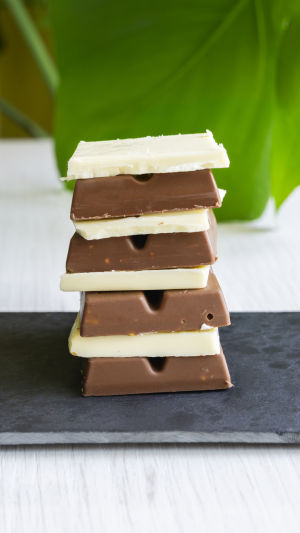Chocolate, with its tantalizing aroma and delectable taste, has held a cherished place in the hearts of countless individuals around the world.
Among the various forms of this sweet indulgence, white and dark chocolate stand as polar opposites, each with its unique characteristics and flavors. While both derive from the cacao bean, their distinctions lie in their composition, taste, and culinary applications.
Let's delve into the intriguing world of white and dark chocolate, unraveling the nuances that set them apart.
The Cacao Conundrum
At the heart of the white and dark chocolate differentiation lies the cacao bean. Dark chocolate, often revered for its intense, rich flavor, is made from cacao solids and cacao butter, with minimal added sugar.
This results in its distinct bitterness and deeply satisfying cocoa notes. On the other hand, white chocolate deviates from this tradition. It lacks cacao solids but contains cacao butter, milk solids, and sugar. This absence of cacao solids lends white chocolate its creamy and smooth texture, along with a milder, sweeter taste profile.
Flavor Spectrum: Bitter vs. Sweet Symphony
One of the most apparent distinctions between white and dark chocolate is their flavor profiles. Dark chocolate, with its higher cacao content, showcases a complex array of flavors. The bitterness of cacao interplays with hints of fruity, earthy, and sometimes even floral notes.
The nuanced taste is often described as robust and intense, making it a choice for connoisseurs seeking a more sophisticated treat.
In contrast, white chocolate offers a completely different sensory experience. The absence of cacao solids results in a more straightforward, sugary taste. Creaminess and milky sweetness dominate the palate, with undertones of vanilla and caramel. The overall impression is lighter and less intense, making it a popular choice among those with a penchant for milder indulgences.
Culinary Applications: Artistry on the Plate
The distinct characteristics of white and dark chocolate extend beyond their flavor profiles, influencing their uses in culinary creations. Dark chocolate's rich and complex flavors make it a versatile ingredient in both sweet and savory dishes.
It can be employed in desserts such as chocolate cakes, truffles, and mousses, as well as in sauces and marinades for meat dishes. Its bitterness can also serve as a balancing element in dishes that require a hint of sophistication.
White chocolate, with its sweetness and smooth texture, lends itself beautifully to desserts that require a luscious, creamy quality. It can be melted into ganache for frosting, incorporated into cheesecakes for a velvety texture, or drizzled over fruits to add a touch of decadence.
Moreover, its compatibility with various flavors makes it an ideal canvas for experimentation and fusion, allowing chefs to create innovative desserts that delight the palate.
Nutritional Profile: Deciphering Delicacies
When considering the nutritional aspects, the difference between white and dark chocolate becomes evident. Dark chocolate's higher cacao content brings forth certain health benefits.
Cacao is rich in antioxidants, particularly flavonoids, which have been linked to various potential health advantages, including improved heart health. The lower sugar content in dark chocolate also contributes to its overall appeal as a relatively healthier option.
On the other hand, white chocolate, due to its significant sugar and milk solids content, tends to be higher in calories and lacks the same antioxidant benefits as dark chocolate. While it might not boast the same potential health advantages, its sweetness and creaminess make it an occasional treat that can bring pure joy to those indulging in its delights.
In the realm of confectionery, white and dark chocolate stand as prime examples of contrasts and complements. From their composition and flavor profiles to their culinary applications and nutritional differences, these two variants offer unique experiences to chocolate enthusiasts.
Whether you're drawn to the robust bitterness of dark chocolate or the creamy sweetness of white chocolate, the world of cocoa provides an array of delights to explore, savor, and enjoy.





